Celtic Symbols and Their Meanings
Welcome to our celtic symbols page.
The celts had a lot of symbols in their lore, this page features some of the most popular knots, and symbols that the celtic people recognized and used in their symbolism.
Included below are pictures along with the descriptions and meanings of the symbols.
Triquetra Symbol
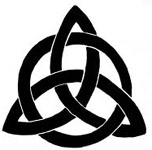
This symbol is also known as the trinity knot. The more common triquetra symbol is below. The word triquetra originally meant "triangle" and was used to describe triangle-shaped objects. The triquetra is most known for it's meaning as the trinity (the Father, the Son, and the Holy Spirit). This meaning was used by the Celtic Christian Church. The triquetra has also been used quite often by the Celtic Christian Church in the form of 3 fishes forming a triquetra. The triquetra is a very old symbol and many say it predates Christianity, the symbol represented the Goddess in Celtic lore. The Trinity Knot holds major significance in neopaganism in that it is believed to represent the three stages of the Triple Goddess (Maiden, Mother, and Crone).
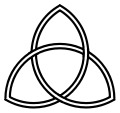
The triquetra, also known as the trinity knot, is one of the most recognized of all Celtic symbols. It represents the three stages of life - Maiden, Mother and Wise Woman.
This design is featured on the cover of a replica of the Book of Shadows central to the television series Charmed.
The Celtic Christian church used the triquetra to represent the Holy Trinity whereas other cultures attached their own meanings to this symbol.
Modern Pagans use the triquetra to symbolize a variety of concepts and mythological figures. Germanic Neopagan groups who use the triquetra to symbolize their faith generally believe it is originally of Norse and Germanic origins.
Sheela Na Gig Symbol
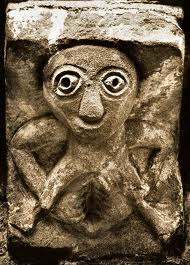
Sheela na gigs are figurative carvings of naked women displaying an exaggerated vulva. They are found on churches, castles and other buildings, particularly in Ireland and Britain.
The figure is meant to represent a survival of pagan, usually Celtic beliefs which have been incorporated into the newcomer Christian church.
Sheela Na Gigs were placed above windows and doors to prevent the devil/evil from entering.
Celtic Triple Spiral Symbol
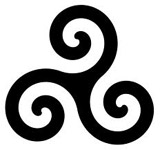
A triskelion or triskele is a motif consisting of three interlocked spirals.
The triple spiral is one of the main symbols of Celtic Reconstructionist Paganism, often standing for the "three realms" - Land, Sea and Sky, or for one of a number of deities who are described in the lore as "threefold" or triadic.
The god Manannán is probably most often the one symbolized by the triskele, though some also use it for the goddess Brighid. Some Celtic-inspired Wiccans also use the triple spiral symbol, most often to represent the concept of the triple goddess.
Celtic Cross Symbol

In Ireland, it is a popular legend that the Celtic Christian cross was introduced by Saint Patrick or possibly Saint Declan during his time converting the pagan Irish, though there are no examples from this early period. It has often been claimed that Patrick combined the symbol of Christianity with the sun cross, to give pagan followers an idea of the importance of the cross by linking it with the idea of the life-giving properties of the sun. The Cross did not become a common symbol of Christianity until the 4th century.
Celtic Shamrock Symbol
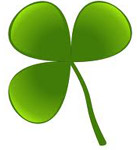
It would seem that the origins of the shamrock are lost in antiquity.
Legends suggest that St. Patrick plucked a shamrock from Irish soil to demonstrate the meaning of the Trinity- Father, Son, and Holy Spirit. The plant was reputed to have mystic powers in that its petals will stand upright to warn of an approaching storm.
The shamrock is also commonly associated with the symbol of luck.
In studying Celtic history, scholars have discovered that the shamrock was a charm to ward away evil. The shamrock remains Ireland's most famous symbol.
Celtic Shield Symbol
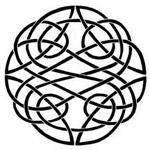
Celtic shield knots can be identified as any of the Celtic knots with four distinct corner areas. They usually resemble a square but sometimes they are a square shaped emblem within a circle. As in all Celtic knots there is no beginning and no end. The Celtic shield knot idea comes from civilizations more ancient than the Celts. Anciently, it was a universally known symbol for protection from danger and warding off evil spirits. The symbol is always fourfold based, but within a greater unity.
Taranis Wheel Symbol
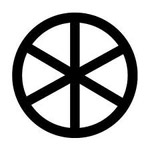
In Celtic mythology Taranis was the god of thunder worshipped essentially in Gaul, the British Isles, but also in the Rhineland and Danube regions amongst others.
Many representations of a bearded god with a thunderbolt in one hand and a wheel in the other have been recovered from Gaul, where this deity apparently came to be syncretised with Jupiter.
The Taranis wheel, more specifically the chariot wheel with six or eight spokes, was an important symbol in historical Celtic polytheism, apparently associated with a specific god, known as the wheel-god, identified as the sky, sun, or thunder-god, whose name is attested as Taranis by Lucan. Numerous Celtic coins also depict such a wheel.
It is thought to correspond to a sun-cult practiced in Bronze Age Europe, the wheel representing the sun.
Celtic Knot Symbol
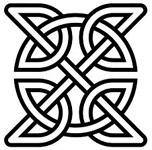
There are many types of celtic knots, each with different meanings. Here are a few of the meanings of celtic knots.
The Eternity Celtic knot symbolizes the never-ending eternal circle of life.
The Shield Celtic knot is a symbol for protection. The ancient Celts used it to decorate the shields of warriors, the clothing of children, and to protect the sick.
Five Fold Symbol
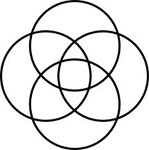
This symbol is associated with the Celtic Arwen symbol which represents the balance of human nature. Scholars have studied different Celtic symbols and came with the conclusion that this represents the five fundamental elements of the universe which are earth, water, sun, air, and fire.
The center circle represents unification of all elements and shows their boundless connections. Some also believe that the Five Fold Symbol is the union of the four seasons of summer, winter, fall and spring.
Awen Symbol
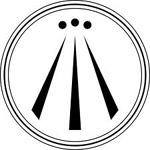
The Order of Bards, Ovates and Druids, describe the three lines as rays emanating from three points of light, with those points representing the triple aspect of deity and, also, the points at which the sun rises on the equinoxes and solstices - known as the Triad of the Sunrises. The emblem as used by the OBOD is surrounded by three circles representing the three circles of creation.
Various Neo-druid groups and individuals have their own interpretation of the Awen. The three lines relate to earth, sea and air; body, mind and spirit; or love, wisdom and truth. It is also said that the Awen stands for not simply inspiration, but for inspiration of truth; without Awen one cannot proclaim truth. The three foundations of Awen are the understanding of truth, the love of truth, and the maintaining of truth. The rays also stand for the letters from which all others evolved: I, O, and U.
Circular Celtic Knot Symbol
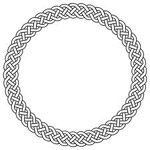
The interlacing lines of the Celtic circular knot stands for "no beginning, no ending, the continuity of everlasting love and binding together or intertwining of two soul or spirits.
Celtic knots are incorporated in a variety of design ideas and are a popular choice for jewelry and tattoos.
Claddagh Symbol
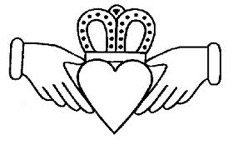
The Claddagh ring is a traditional Irish ring given as a token of friendship, love, or marriage.
The design and customs associated with it originated in the Irish fishing village of Claddagh, located just outside the city of Galway.
The elements of this symbol are often said to correspond to the qualities of love (the heart), friendship (the hands), and loyalty (the crown).
Celtic Tree of Life Symbol
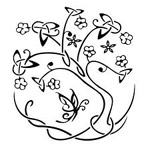
According to the Celts, trees were considered ancient living beings that played a very important role in their lives. With their roots firmly planted in the ground and their branches reaching high in the sky sacred trees connect us to the supernatural world, spirits and our ancestors.
Before Christianity, people were said to worship the trees.
Our ancestors believed that trees were sacred, powerful symbols of growth, death, and rebirth.
Some ancient Celts believed the trees represented balance and harmony in life.
Follow this link to learn more about tree symbolism and their meanings.
